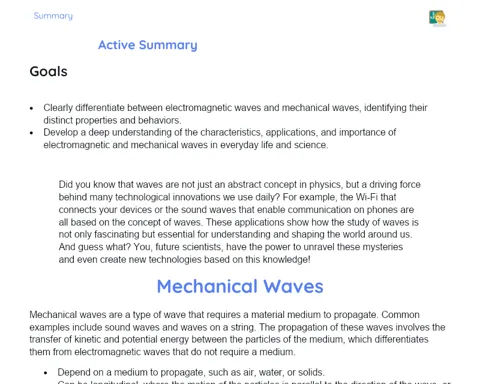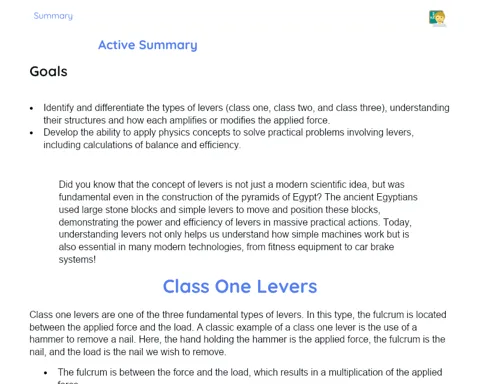Simple Harmonic Motion: Relationship between SHM and UCM | Traditional Summary
Contextualization
Simple Harmonic Motion (SHM) is a type of oscillatory motion that occurs in various physical systems, such as pendulums, springs, and even in electrical circuits. This motion is characterized by a restoring force that is directly proportional to the displacement of the object from its equilibrium point, acting in the opposite direction to that displacement. Understanding SHM is fundamental for analyzing many physical phenomena, as it serves as an idealized model that can be applied to a variety of practical situations.
To deepen the understanding of SHM, it is helpful to relate it to Uniform Circular Motion (UCM). UCM describes the motion of an object moving along a circular path with constant angular velocity. When we observe the projection of a point in uniform circular motion onto one of the axes of a coordinate system, we see that this projection performs simple harmonic motion. The relationship between SHM and UCM not only facilitates the understanding of the involved concepts but also allows practical application for calculating velocities and deformations in real physical systems. Analyzing this relationship is a powerful tool in physics and engineering, providing valuable insights for solving complex problems.
Definition of Simple Harmonic Motion (SHM)
Simple Harmonic Motion (SHM) is a type of oscillatory motion that occurs when the restoring force is directly proportional to the displacement and acts in the opposite direction to the displacement. This force is often expressed by Hooke's Law, which states that F = -kx, where k is the elasticity constant of the system and x is the displacement from the equilibrium point.
An essential characteristic of SHM is that it is periodic, meaning the motion repeats at regular time intervals. The period (T) is the time required to complete a full cycle of motion, while the frequency (f) is the number of cycles per unit of time. The amplitude (A) is the maximum value of the displacement from the equilibrium point.
SHM can be mathematically described by the equation x(t) = A * cos(ωt + φ), where ω is the angular frequency, t is time, and φ is the initial phase. This equation shows that the motion is sinusoidal, meaning it follows a cosine or sine function over time. This mathematical representation facilitates the understanding and analysis of the motion.
-
Restoring force proportional to displacement.
-
Periodic motion with period (T) and frequency (f).
-
Amplitude (A) is the maximum displacement.
-
Mathematical equation: x(t) = A * cos(ωt + φ).
Uniform Circular Motion (UCM)
Uniform Circular Motion (UCM) is the movement of a body that moves along a circular trajectory with constant angular velocity. In UCM, the linear velocity of the object is constant in magnitude, but its direction continuously changes to follow the circular path.
The main quantities involved in UCM are the radius (R) of the circular trajectory, the angular velocity (ω), and the centripetal acceleration (a_c). The angular velocity is the rate of change of the angle concerning time, while centripetal acceleration is the acceleration directed towards the center of the circular path, keeping the object in circular motion.
Mathematically, the motion can be described by the equations x(t) = R * cos(ωt) and y(t) = R * sin(ωt), where R is the radius, ω is the angular velocity, and t is time. These equations show that the position of the object at any instance can be determined using trigonometric functions, facilitating motion analysis.
-
Circular trajectory with constant angular velocity.
-
Constant linear velocity in magnitude, but variable direction.
-
Centripetal acceleration directed towards the center of the trajectory.
-
Mathematical equations: x(t) = R * cos(ωt), y(t) = R * sin(ωt).
Relationship between SHM and UCM
The relationship between Simple Harmonic Motion (SHM) and Uniform Circular Motion (UCM) can be understood by observing the projection of a point in uniform circular motion onto one of the axes of a coordinate system. When a point moves along a circular trajectory, its projection onto an axis performs simple harmonic motion.
In UCM, the point moves along the perimeter of a circle with radius R and angular velocity ω. When we project this motion onto one of the axes, we obtain an oscillation that follows the characteristics of SHM, with the amplitude being equal to the radius of the circle (R) and the angular frequency (ω) being the same in both motions.
This relationship is extremely useful because it allows SHM problems to be solved using concepts and equations from UCM. For example, the maximum velocity in SHM corresponds to the tangential velocity in UCM, and the maximum acceleration in SHM corresponds to the centripetal acceleration in UCM. This facilitates the understanding and resolution of complex problems involving oscillations.
-
Projection of a point in UCM results in SHM.
-
Amplitude of SHM is equal to the radius of UCM.
-
Angular frequency (ω) is the same in both motions.
-
Maximum velocity and acceleration in SHM correspond to those in UCM.
Equations of SHM and UCM
The mathematical equations that describe Simple Harmonic Motion (SHM) and Uniform Circular Motion (UCM) are powerful tools for analyzing these movements. In the case of SHM, the position of the object over time can be described by the equation x(t) = A * cos(ωt + φ), where A is the amplitude, ω is the angular frequency, t is time, and φ is the initial phase.
For UCM, the equations that describe the position of the object in a two-dimensional plane are x(t) = R * cos(ωt) and y(t) = R * sin(ωt), where R is the radius of the circular trajectory and ω is the angular velocity. These equations show that the position of the object at any instance can be determined using trigonometric functions.
The connection between these equations is fundamental for understanding the relationship between SHM and UCM. The projection of UCM onto an axis results in the equation of SHM, demonstrating that SHM is, in fact, a linear representation of UCM. This means that many problems involving oscillations can be solved using the equations of circular motion.
-
Equation of SHM: x(t) = A * cos(ωt + φ).
-
Equations of UCM: x(t) = R * cos(ωt), y(t) = R * sin(ωt).
-
Projection of UCM onto an axis results in the equation of SHM.
-
Use of the equations facilitates the resolution of oscillation problems.
To Remember
-
Simple Harmonic Motion (SHM): Oscillatory motion with restoring force proportional to displacement.
-
Uniform Circular Motion (UCM): Motion in a circular trajectory with constant angular velocity.
-
Frequency: Number of cycles per unit of time in SHM.
-
Period: Time required to complete a cycle of motion in SHM or UCM.
-
Amplitude: Maximum displacement from the equilibrium point in SHM.
-
Angular Velocity (ω): Rate of change of the angle in UCM.
-
Centripetal Acceleration: Acceleration directed towards the center of the circular trajectory in UCM.
-
Projection: Representation of the motion of a point in UCM onto an axis, resulting in SHM.
-
Equation of SHM: x(t) = A * cos(ωt + φ).
-
Equations of UCM: x(t) = R * cos(ωt), y(t) = R * sin(ωt).
Conclusion
In this lesson, we explored the definition and characteristics of Simple Harmonic Motion (SHM), identifying its periodicity, amplitude, and the restoring force proportional to displacement. Additionally, we discussed Uniform Circular Motion (UCM), highlighting the circular trajectory with constant angular velocity and the centripetal acceleration that keeps the body in circular motion.
The relationship between SHM and UCM was detailed, showing how the projection of a point in UCM results in simple harmonic motion. This connection facilitates the understanding of oscillations in real physical systems, such as pendulums and mass-spring systems, allowing for practical and intuitive calculations of velocity and acceleration.
Finally, the mathematical equations that describe SHM and UCM were presented, highlighting how these formulas can be used to solve oscillation problems. Understanding these equations and the relationship between SHM and UCM is fundamental for the practical application of concepts and for solving complex problems in physics and engineering.
Study Tips
-
Review the mathematical equations of SHM and UCM, practicing problem-solving to consolidate the understanding of the relationships between these quantities.
-
Utilize additional resources, such as videos and online simulations, to visualize simple harmonic motion and uniform circular motion, facilitating the understanding of the concepts.
-
Form study groups to discuss and solve practical problems involving SHM and UCM, exchanging ideas and clarifying doubts with peers.



